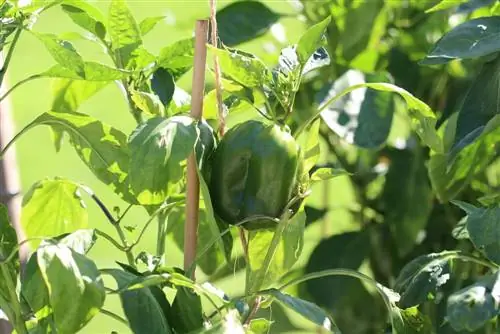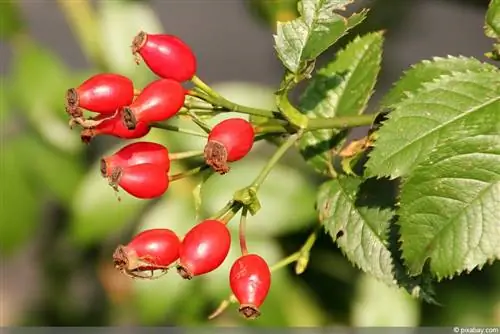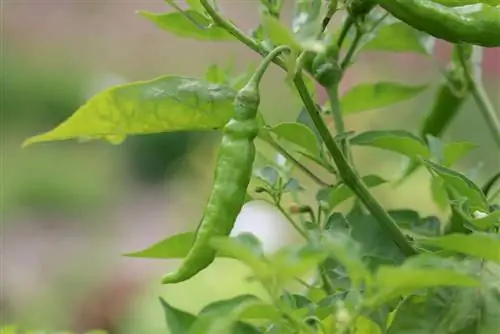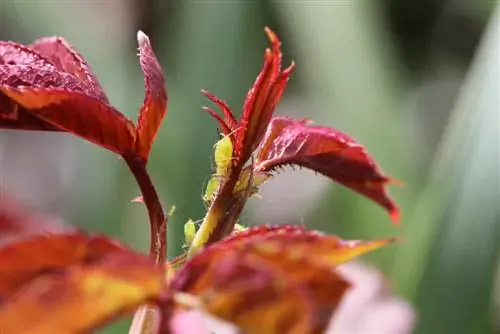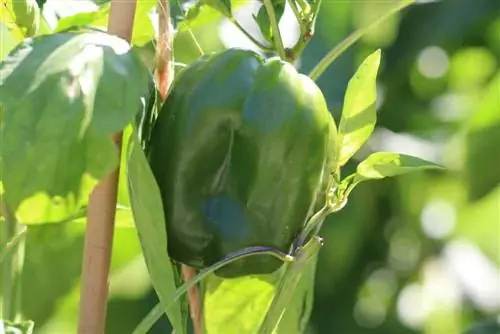- Author admin [email protected].
- Public 2023-12-17 03:39.
- Last modified 2025-06-01 06:48.
The most striking area of the pepper tree is the leaves. Although they are relatively small, they shine enormously. If you cook these leaves, you get a delicious seasoning that is also often called Szechuan pepper. The pepper tree can also be cultivated as a bonsai. Some measures are necessary to ensure that it thrives completely in the pot.
Important for a pepper tree:
- lots of sun
- Attention
- an ideal location even in winter
- a pot where it can grow optimally
Finding the ideal location
If you want to care for a pepper tree in a pot, you should take care of the perfect spot in advance. The tree needs bright places. A semi-sunny location in the north, east or west would be even better. If you live in dark rooms, it's better to get another plant or perhaps use good plant light.
The best place to overwinter
The pepper tree likes the sun, but it shouldn't be too warm. 10°C - 18°C would be ideal. If it is kept in a place where the humidity is higher, it can also have warmer temperatures for overwintering. He feels most comfortable on moist lava granules or expanded clay. Even in winter, the bonsai actually needs a lot of light to thrive. In some areas, the mini tree can be left outside, provided you don't leave it unprotected. Use Styrofoam or similar insulating material to keep wind and ice away from him.
Repotting made easy
Caring for this plant is not really difficult. Every two years, the old soil is disposed of and exchanged for new. It is not necessary to empty the entire pot, the old soil around it should be sufficient. The thin roots of the bonsai are loosened with a root claw and the hair root is cut back by up to a third. Once this is done, the bonsai is repotted with fresh soil. It is always advisable to change the pot as the plant and its roots become more impressive. As I said, completely new soil is not necessary. Simply mix the old and new, the bonsai should feel right at home.
Caution: Aphids gnaw on the leaves
Sometimes aphids or mealybugs form directly under the leaf panicles at the branching points. These are small white dots that are also called thrips. If you observe such structures, it is best to resort to spray. This eliminates the biting pests and the bonsai can continue to grow without worry. The spray should be used about three times within a week.
Fertilize and water
If it is a warm winter, the bonsai needs liquid fertilizer once a month. If the winter is cool, no fertilizer is necessary between October and March.
Between spring and autumn, the pepper tree is always in a kind of growth phase. During this time you should water regularly. It doesn't matter if the soil dries out a little, but it shouldn't dry out completely. The exact watering rhythm is difficult to explain as it depends on several factors. For example, the size of the pot, sun, etc. As a rule, the bonsai is watered every two to four days. For small plants, an immersion bath can also be implemented: the entire tree is placed in a bowl of water for about two minutes. The soil absorbs water and waters itself. In winter, in a cool room, every four to seven days is enough. Water every two to three days in warm locations. If the pepper tree stays outside in winter quarters, every sixteen days is enough.
Cutting and propagating
A pepper tree grows and panicles of leaves form. These can stay on, unless they form eight panicles on top of each other on a fresh branch, so the first ones can disappear. In general, the bonsai should be cut back every two years so that it does not grow too wide.
Bonsai trees are, strictly speaking, normal trees. That's why there are no dedicated seeds for it. They are offered, but basically they are just any tree. They become bonsai trees by growing in pots. This means that every tree seed can be used for bonsai cultivation. If you want it to be a special pepper tree, just look for it or ask for cuttings from mature trees that are within reach. The trick to why the tree stays so small is that it grows in a pot. If it were planted in nature, it would miraculously grow much larger and thrive. A bonsai is a little reminiscent of magic, but can be easily explained. Beginners are best placed on a young plant that is three to seven years old but is still growing. These are available for less than 20 euros and gardeners can save themselves tedious work.
What you should know about the “big” pepper tree
The pepper tree is an uncomplicated tree species to gain initial experience with bonsai and also carry out breeding experiments yourself. However, there are also two other types of pepper tree:
- On the one hand the Peruvian pepper tree and on the other hand the Brazilian pepper tree.
- Both species, as the names suggest, are at home in warmer climates.
- We only thrive in our greenhouse because they are very sensitive to frost. These trees do not survive temperatures below 5 degrees Celsius.
The Peruvian pepper tree grows up to fifteen meters high and has drooping leaves up to fifteen centimeters long. When it is in bloom, small white-yellow flowers form, which then produce beautiful red berries with a pepper-like taste. The berries give this tree its name, but they are also slightly poisonous.
The Brazilian pepper tree grows up to nine meters high and has greenish to bronze pinnate leaves. It also has small white-yellow flowers, but only in summer. The fruits are green and then ripen into red berries. Dense panicles of these red fruits are often used as Christmas decorations. The fruits are also used as a spice, even if they are not real pepper.
If you want to grow a pepper tree, you have to, as I said, respond to the tree's needs and create the conditions it needs to grow and thrive. And the first thing that comes with it is warmth.


